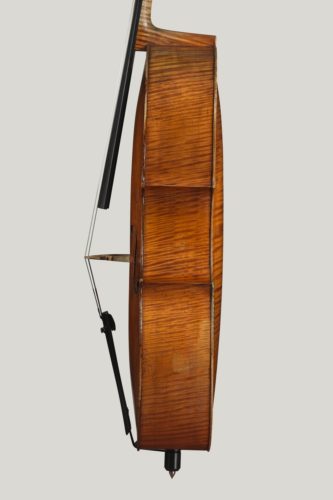Simone Fernando Sacconi
Cello made by Simone Fernando Sacconi in 1917. María Alejandra Conde-Campos plays on this instrument.
Simone Fernando Sacconi was the defining master of 20th century violinmaking.
Born in Rome in 1895, he moved to New York in 1931 to work for the violin dealer Emil Herrmann. He subsequently joined the distinguished company of Rembert Wurlitzer, where he worked from 1950 until his retirement. During this time he taught many of the best makers of the next generation and developed sophisticated restoration techniques which have become standard practice in modern workshops. A dedicated craftsman and the maker of some of the finest new instruments as well as a charismatic teacher, he devoted much of his life to the study of Stradivari.
His seminal book I Segreti di Stradivari was published in 1972, presenting to the world the fruits of his life’s work just before his death in 1973. It remains the primary source on the subject for modern makers, and revealed for the first time many of the techniques used by the master. In 1972 he was also made an honorary citizen of Cremona.
His precocious talent is illustrated by the cello belonging to Dextra Musica. A professional maker since the age of 16, Sacconi received the commission to build this instrument in about 1917 from the cellist Gaspar Cassado. At the time, both men were barely in their twenties and at the start of prestigious careers; Cassado later became a professor at the Academia Chigiana in Sienna. The commission was possibly inspired by Sacconi’s earlier highly successful copy of the “Berthier” Stradivari cello, which belonged to Franz von Vecsey.
Cassado also asked for a copy of a Stradivari cello, with antiqued varnish representing the age of the original. He used the Sacconi in performance and recording for many years before passing it to his pupil at the Academia Chigiana, Inger Jarl Hansen, in 1965, a year before his own death. Cassado had by then acquired an original Stradivari, the “ex-Romberg” of 1709. In a personal note made at the time of the sale, Cassado recalled that Sacconi built his instrument over seven or eight months, with several more months devoted to the application of thirty coats of varnish.
It remains a stunning instrument, a beautiful and accurately rendered copy of the great cellos Stradivari made between 1710 and 1730. These are considered amongst his finest woks, and the pattern he designated his “B” form has remained the standard model for the cello to this day.
Sacconi used some wonderfully figured maple for the back and ribs of the instrument, perfectly capturing the character of the wood used by Stradivari in his greatest period, married to a perfect piece of fine-grained alpine spruce which is jointed to make up the front. The neck and head, as was Stradivari’s own practice, are made of plainer wood, allowing the elegantly carved turns of the scroll to speak for themselves.
The chamfer is faithfully picked out in black ink, but the whole head, like the rest of the instrument, is ingeniously rubbed and patinated to give the appearance of 200 years of use. As a result, the rich red varnish, which as Cassado noted was built up painstakingly with repeated coats, has a depth and beauty which stands comparison with its inspiration.

María Alejandra Conde-Campos
María Alejandra Conde-Campos is a classical cellist and educator. She studied with Truls Mørk at the Norwegian Academy of Music and holds a Master’s degree from the Barratt Due Institute of Music. Today, she works as a cello teacher at the Barratt Due Institute of Music and combines this role with freelance work for Norwegian […]









